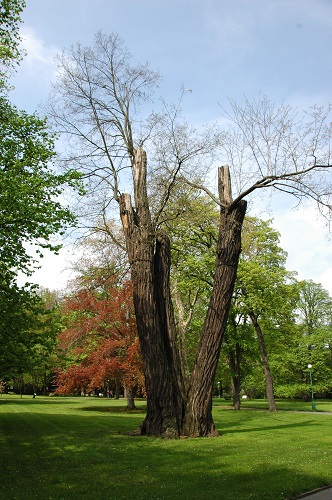I’ve been traveling in Europe the past few days working on a project with some colleagues in the Czech Republic. While we typically think of our friends in Europe as being more progressive and cultured than us, it appears there are still a few areas where they have a ways to go – such as banning smoking from restaurants and bars – and in learning about the art and science of Arboriculture. (And before the hate mail from Europe starts pouring in; yes, I realize we can find plenty of scenes like this in the US – just hoped I’d find better on this side of the pond).

I’m not a big Forsythia fan, but really…?

Not sure what the desired outcome is here.

This is a black locust near Prague castle. Black locust, which is native to North America, was introduced to Europe for forestry planting in the 19th Century. The trees were extremely well adapted and have become invasive in many parts of Europe, out-competing native trees and suppressing the development of understory plants. This particular specimen is one of the oldest in the Czech Republic, which presumably is the reason it has been allowed to linger on. A good example of when a tree’s quality of life has run its course. It truly pained me to look at this tree. And, of course, in the U.S. the tree would probably have been long gone due to liability concerns.

The tree is mostly hollow and was once cabled together. The cables were removed after the tree lost its tops in a storm 20 years ago.

It appears that the tree’s principle function these days is feeding woodpeckers.

OK, in the interest of international diplomacy, something Europeans get right is pollarding. In the U.S. what is passed off as pollarding is usually just topping. But when it’s done right (in this case with horseschestnut) and in the right setting (Prague Royal Gardens) it can create a striking effect.
I saw a pollard line of trees acting as a fence row between 2 fields in the Netherlands. It was perfect for that setting and made me wonder why we don’t do that in the US.
Bert, no hate mail from Europe but you certainly know better than to make generalised assumptions and statements about “Europe” and “Europeans” based on a few examples from one country be it smoking bans or the art and science of Arboriculture. No need to look for ignorance and foolishness as well as acts of horticultural violence on a map, these can be easily found anywhere. It appears there are still lots of areas where we all have a ways to go …
Point taken, Johannes. My impression from travels in Europe (Czech Republic, Germany, Austria, Italy, and France) is that public smoking is more common than I’m used to. To be fair, some US states h
ave not banned public smoking or have smoking/non-smoking sections – which is like having peeing/non-peeing sections in a swimming pool…
Back to Johannes’ main point, I’m guilty of violating one of my cardinal rules: Anytime we start generalizing about ‘them’ or ‘those people’ an alarm should go off in our heads.
I have to confess I’m guilty too. It’s not that I haven’t ever started a sentence with “Those Americans are …”
But still … the pictures of the Forsythia stumps and that butchered shrub are horrible. And the sad thing is I could easily take very similar photos in my neighbourhood here …
The butchering of trees and shrubs is also common in Sweden where I reside, although presently I am in San Diego for a visit. There doesn’t appear to be any creature thought that goes into sculpting trees and shrubs. Most of the workers in the landscape biz there are summer holiday jobs being handled by college students. As far as Prague goes, I love that city, but perhaps you also saw and experienced the dog feces everywhere ? This was also my experience in Amsterdam in the past. Smoking is a big problem in Europe, but especially in Czech Republic where laws are definitely lax or absent altogether.
San Francisco has a really splendid and well-maintained example of pollarded trees, next to the de Young Museum in Golden Gate Park. When I visited my sister there I learned that many visitors incorrectly presume these to be Joshua trees, so little is the pollarding art known.
Loved it! Thanks! Perhaps I can send you my collection of volcano pictures, my ongoing rant of abuse…
A few years ago I was traveling in The Netherlands and saw a badly butchered beech tree that would have otherwise been beautiful; probably 3′ in diameter. I had seen a lot of pollarding but this was extreme… anyway, it seems it is illegal to cut down a healthy tree in some areas and people will work around this law by making horrible pruning cuts. When the tree dies or becomes a bad enough hazard, it will be legal to remove it. (This was at the keukenhof, btw)
I suspect this may be what’s happening with those trees. Though I’m not sure what’s happened to those shrubs.
The term Horticultural Violence had me giggling but i abhor the act.